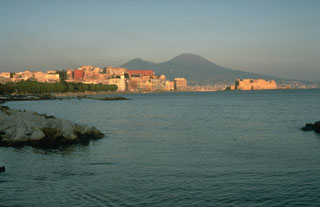Report on Vesuvius (Italy) — October 1999
Bulletin of the Global Volcanism Network, vol. 24, no. 10 (October 1999)
Managing Editor: Richard Wunderman.
Vesuvius (Italy) 9 October seismic swarm includes an M ~ 3.5 event, the largest in 50 years
Please cite this report as:
Global Volcanism Program, 1999. Report on Vesuvius (Italy) (Wunderman, R., ed.). Bulletin of the Global Volcanism Network, 24:10. Smithsonian Institution. https://doi.org/10.5479/si.GVP.BGVN199910-211020
Vesuvius
Italy
40.821°N, 14.426°E; summit elev. 1281 m
All times are local (unless otherwise noted)
At the beginning of October a small cluster of seismic events was recorded by the permanent seismic network of the Osservatorio Vesuviano (figure 4). The most energetic event of the sequence occurred at 0741 on 9 October, with a duration magnitude (MD) of 3.6 and a Wood Anderson equivalent magnitude (MWA) of 3.4. This event was located in the crater area at a depth of about 3 km below sea level, with a preliminary stress-drop of 164 bar and a preliminary moment magnitude of 3.3. According to its MD value, this event was the most energetic of the last 50 years. Its fault plane solution showed a strike slip mechanism. All the events in this sequence were located below the crater area within the first 6 km of the upper crust, typical of seismicity at Vesuvius in recent years.
 |
Figure 4. Seismic activity at Vesuvius during 1 January-17 November 1999, showing the monthly number of events (histogram) and strain release (line). Courtesy of the Osservatorio Vesuviano. |
During the swarm no changes were observed in the temperature or the composition of the fumaroles, in the CO2 flux from soil, or in ground deformation. Both the temperature and the level of the water-table sampled around the volcano appeared unchanged. As of mid-November seismicity seems to have returned to normal low background levels (both in terms of energy and in number of events) that have characterized Vesuvius for several years.
Geological Summary. One of the world's most noted volcanoes, Vesuvius (Vesuvio) forms a dramatic backdrop to the Bay of Naples. The active cone was constructed within a large caldera of the older Monte Somma edifice, thought to have formed incrementally beginning about 17,000 years ago. The Monte Somma caldera wall has channeled lava flows and pyroclastic flows primarily to the south and west. Eight major explosive eruptions have taken place in the last 17,000 years, often accompanied by large pyroclastic flows and surges, such as during the 79 CE Pompeii eruption. Intermittent eruptions since 79 CE were followed by a period of frequent long-term explosive and effusive eruptions between 1631 and 1944. The large 1631 eruption produced pyroclastic flows that reached as far as the coast and caused great destruction. Many towns are located on the flanks, and several million people live within areas that could be affected by eruptions.
Information Contacts: Lucia Civetta, Edoardo Del Pezzo, Francesca Bianco, Giuseppe Vilardo, and Mario Castellano, Osservatorio Vesuviano, Via Diocleziano 328, 80124 Napoli, Italy.

